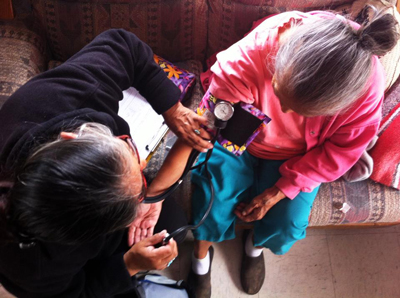COPE Brings Cross-Pollination to Navajo Nation
 |
| A health worker makes a home visit in Navajo Nation. |
On one of Dr. Sara Selig's first visits to Navajo Nation as a resident in the Division of Global Health Equity, she went to the home of a man in his late 20s with uncontrolled diabetes. A young father, one of his legs had already been amputated due to the disease, and Selig was concerned he was developing even more complications from his diabetes.
The Community Outreach & Patient Empowerment Program, or COPE for short, was started five years ago to help high-risk people with diabetes living in two areas of Navajo Nation. Today, COPE has expanded to cover the entire Navajo Nation and works across the spectrum of chronic diseases.
COPE partners with the Navajo Nation to improve the health of high-risk patients through initiatives such as providing educational materials like flip charts to use with patients and training community health workers on helping patients set and achieve goals.
 |
| COPE Director Sonya Shin, MD from Brigham and Women's Hospital and Didi Bertrand Farmer from Partners In Health both spoke at the symposium. |
Recently COPE held a first-of-its-kind symposium on April 23-24 in Window Rock, AZ, the capitol of Navajo Nation. The event drew approximately 150 participants, from clinic-based physicians and nurses to community health workers, public health nurses, and even drivers, who often act as translators for health workers making home visits. The faculty consisted of both local and international experts, many of whom were affiliated with COPE's partner organizations of BWH, the Indian Health Service, Partners In Health, and Harvard University.
"We wanted to highlight what is going on in and around Navajo Nation, as well as bring in the global perspective. By connecting attendees to the larger national and international scene, we cross-pollinate with outside experts and let them know that the problems on Navajo Nation are also faced in other parts of the world," says Selig, now a faculty member in the Division of Global Health Equity and associate director of COPE.
Learning From One Another
Four panels at the symposium examined innovations and new models for technology, nursing, clinics and community health workers. After each panel, attendees broke into small groups to brainstorm potential next steps, and the diversity of professions participating brought many fresh ideas and perspectives to this process. Despite serving the same population, many of these professionals had never spoken with each other before the symposium.
Progress is already being made on several initiatives that grew out of the symposium, including empowering and supporting nurses to lead change; using technology to strengthen communication between clinics, community health workers, and patients; and facilitating collaboration and cross-training for community health workers.
A Nation in Need
Most of COPE's funding comes from the non-profit Rx Foundation, but the symposium highlighted the urgent need for more interventions and investments.
"We are so fortunate to have people willing to donate their time and expertise, and this work would not happen without them. But many of these initiatives will also require funding to get off the ground, and we don't know where that's coming from," said Selig.
COPE's work is greatly needed. Navajo Nation is the largest tribe in the United States, with approximately 200,000 people living in a rural area of the southwestern Unites States the size of Massachusetts, New Hampshire, Rhode Island, and Connecticut combined. Roughly 20 percent of people on Navajo Nation are living with diabetes, one of the highest rates anywhere in the world.
Howard Hiatt, MD, associate chief of the Division of Global Health Equity was inspired to co-found COPE after visiting Navajo Nation in 2009. "There's surely no group of people to whom we, as Americans, owe more than to Native Americans. And that debt can't be paid, but at least addressed, by a program like COPE."
 |
| The image shows a word cloud based on symposium participants' responses to the event. |